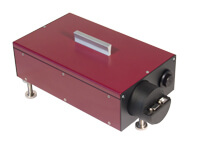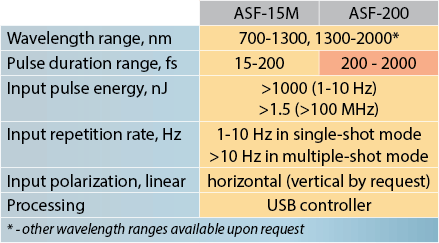ASF single-shot autocorrelator (SSA)
Pulse duration ranges from 20 fs to 2 ps
LabView drivers for easier integration
<1 uJ sensitivity for 1-10 Hz operation for 50-100 fs pulses at 800 nm
USB PC connection and acquisition software

1. General
The ASF single-shot autocorrelator is a handy pulse duration measurement tool for amplifiers and oscillators. Real-time amplifier adjustment is really impossible without assistance of the ASF.
It is equipped with USB connection and LabView drivers for seamless integration into existing setups. The unit is really a workhorse for any lab that needs reliable pulse duration data right at the screen of a PC, or needs this data to be transferred to any other application for storage or feedback purposes.
The two models cover different wavelength ranges: 20 to 200 fs, and 200 fs to 2 ps. Customized wavelengths and pulse duration ranges are available.
2. Specifications
3. Applications
Ultra-short pulse duration measurement
Ultrafast amplifiers and oscillators alignment and monitoring
4. FAQ
Q. What is the beam diameter necessary for pulse duration measurement with the ASF?
A. Due to the geometry of the ASF’s design, the necessary part of the beam is its horizontal dimension, and it should be >2 mm a t 20 fs to around 15 mm at 200 fs for the ASF-20 model. The same applies to the ASF-200, the values are approximately the same: >2 mm at 200 fs to around 15 mm at 2 ps.
Q. How does the sensitivity changes with pulse duration?
A. The pulse energy needed for reliable measurements with the ASF is not a fixed value. The necessary pulse energy changes in squared relation to the pulse duration. Thus, for example, 1 uJ pulse energy at 800 nm will allow to measure 100-fs pulses, but 1-ps pulses will require 100 uJ of pulse energy. This all is true for single-shot operation at 1 to 10 Hz, as the system accumulates pulses while working below 10 Hz in multiple-shot mode. Moreover, the sensitivity can be increased in some cases by using a cylindrical lens. Contact us for more details.
Q. What are the single-shot and multiple-shot regimes?
A. The ASF operates in single-shot regime at pulse repetition rates below 10 Hz and is able to characterize the duration of a single pulse. This is necessary when you have a low repetition rate source, or want to compare single pulses in a pulse train. The multiple-shot regime starts above 10 Hz when the system accumulates pulses and gives the average pulse duration of the accumulated pulses. These regimes are not user-selectable and are defined by the processing speed and refresh rate of the ASF’s CCD camera.
Q. What are the requirements for external trigger signal?
A. If the input repetition rate is equal or less than 10 Hz (the single-shot regime) you should use the external synchronization of the CCD camera. The trigger should be positive, 5-20 V in amplitude, about 1 μs pulse front duration and precede the laser pulse by 20 μs or more.
5. RFQ Hints
Just some quick hints before you send us an RFQ:
1. Check if the sensitivity for the ASF is enough for your application. See FAQ for more info.
2. Let us know if you need vertical input polarization.
3. Check if your beam’s diameter is enough for the particular pulse duration. See the FAQ section for more details.
